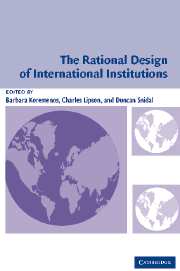Book contents
- Frontmatter
- Contents
- Contributors
- Abstracts
- Title Page
- The Rational Design of International Institutions
- Trust Building, Trust Breaking: The Dilemma of NATO Enlargement
- The Optimal Design of International Trade Institutions: Uncertainty and Escape
- Most-Favored-Nation Clauses and Clustered Negotiations
- Situation Structure and Institutional Design: Reciprocity, Coercion, and Exchange
- Private Justice in a Global Economy: From Litigation to Arbitration
- Multilateralizing Trade and Payments in Postwar Europe
- The Institutional Features of the Prisoners of War Treaties
- Institutions for Flying: How States Built a Market in International Aviation Services
- Driving with the Rearview Mirror: On the Rational Science of Institutional Design
- Rational Design: Looking Back to Move Forward
- References
Institutions for Flying: How States Built a Market in International Aviation Services
Published online by Cambridge University Press: 28 October 2009
- Frontmatter
- Contents
- Contributors
- Abstracts
- Title Page
- The Rational Design of International Institutions
- Trust Building, Trust Breaking: The Dilemma of NATO Enlargement
- The Optimal Design of International Trade Institutions: Uncertainty and Escape
- Most-Favored-Nation Clauses and Clustered Negotiations
- Situation Structure and Institutional Design: Reciprocity, Coercion, and Exchange
- Private Justice in a Global Economy: From Litigation to Arbitration
- Multilateralizing Trade and Payments in Postwar Europe
- The Institutional Features of the Prisoners of War Treaties
- Institutions for Flying: How States Built a Market in International Aviation Services
- Driving with the Rearview Mirror: On the Rational Science of Institutional Design
- Rational Design: Looking Back to Move Forward
- References
Summary
In the aftermath of World War II, states created a complex set of bilateral and multilateral institutions to govern international aviation markets. National governments concluded bilateral agreements to regulate airport entry and capacity and delegated to the airlines, through the International Air Transport Association (IATA), the authority to set fares and terms of service in international markets. Combined, the bilateral agreements and IATA produced national monopolies connected by strictly regulated international markets in which airlines supplied identical services at identically high prices. A mixture of public and private institutions thus produced a de facto cartel in international aviation services.
The cartel, or Bermuda regime, was not simply a set of institutions that facilitated profitable rent seeking, however. Indeed, despite consistent grumbling over the spoils of the cartel, the Bermuda institutions successfully facilitated the dramatic growth of international aviation markets in the postwar period. By the late 1970s, when U.S. policy began to erode the role of the Bermuda institutions in international markets, international aviation, once a small, specialized industry, had become one of the central pieces of the global economy. But the existence and subsequent dramatic growth of the market, which we now take for granted, was not at all self-evident in 1945.
- Type
- Chapter
- Information
- The Rational Design of International Institutions , pp. 233 - 258Publisher: Cambridge University PressPrint publication year: 2003



